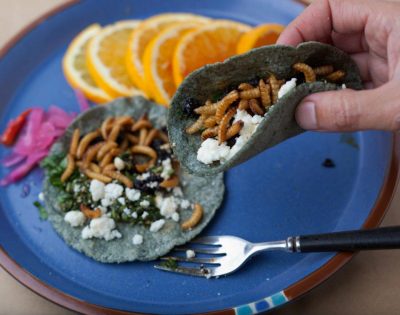By
Olena Kagui
“Entomophagy is an evolving term in need of review,” says Afton Marina Szasz Halloran, Ph.D Fellow at the University of Copenhagen. Halloran calls for a change in the way we speak about edible insects and entomophagy.
Entomophagy is the practice of eating insects, especially by people. Like Halloran, many professionals in the field express a dislike for the archaic term due to its over-simplified definition. The practice of consuming insects goes far beyond culinary innovations and can have groundbreaking environmental, economic and sociocultural impacts.
“Based on my research, small-scale cricket farming has contributed substantially to improving the lives of rural farmers in Thailand,” says Halloran, “They have provided an alternative source of income. It has also allowed some housewives to generate their own income, provided an activity for the elderly and a means of generating a consistent source of income.”
Halloran first sampled nsenene, a long-horned grasshopper, during her studies in Uganda in 2008. Four years later she began working at the Food and Agricultural Organization of the United Nations with the Insects for Food and Feed Programme and helped co-write Edible insects, Future prospects for food and feed security that has been downloaded seven million times and translated into Korean and French. She is a PhD fellow involved in the GREEiNSECT Research Project, led by the University of Copenhagen.
“There are still many misunderstandings including that of insects as the cure to our broken food system,” says Halloran, “Nonetheless, it is my hope that the discourse around edible insects can generate a greater understanding and respect for the diversity of food cultures which will help us to ensure a better and healthier future for both humans and the environment.”
“Because taste guides our preferences for what we eat, I strongly believe that in Europe, if insects do not taste good they will be a short-lived trend,” explains Halloran, who recently gave a lecture to aspiring young chefs together with Roberto Flore, the Head Chef of Nordic Food Lab. “Our lecture was very well received as the students noted that before such a lecture they would not have had the right knowledge to respectively use insects in creating new dishes.”
Governmental regulations can be an obstacle in the mainstream exploration of consuming insects. However the European Novel regulations are changing to explicitly include whole and parts of insects as viable novel foods. In the past few months, countries such as Denmark have begun importing insect-based products from other European countries. Halloran believes this to be a response to the changing regulations that are now being witnessed.
According to Paul Vantomme, spokesman and coordinator for the FAO, the lack of legal framework providing incentive for insect farming is the main road block to making entomophagy more popular. Vantomme believes that the EU can encourage the public to eat insects by raising awareness at EU level and supporting national government initiatives, research funding and education.
“With the rise of consumer awareness about the environmental footprint caused by their food choices, particularly eating red meat, consumers will put pressure on food distributors to produce more insect-based foods,” says Vantomme. He adds that insect production has a low environmental impact and has the potential to make Europe less dependent on imported fish, meat and soy.
Currently, lack of regulation is a hindrance because there are no standards or definitions of “foodgrade” or “GRAS” (Generally Regarded as Safe) status for insects,” says Dr. Aaron T. Dossey, a Ph.D. Biochemist, self-taught Entomologist/Food Scientist and founder of All Things Bugs LLC, “the lack of food grade or GRAS status causes many food companies and processing facilities to not yet accept insects or insect-based food ingredients in their products or facilities.”
Dr. Dossey’s All Things Bugs LLC is a leader in the industry, with over $650,000 in research grants to date from the Gates Foundation and USDA. To date Dossey has sold over 10,000 pounds of cricket powder to a number of companies, universities and individuals. The powder (which Dossey will soon brand as “Griopro”) is a fine, light-colored ingredient with a smooth texture, a mild aroma and flavor. Dossey has received positive reactions to his product. Many of his customers consider the product to be by far the highest quality and the most useful in a wide range of products.
“As with any food product, quality is critical in how people react to it,” Dossey explains, “on the topic of insects in/as food in general, it seems that far more people are open to it than expected.”
According to Dossey, there are seven main challenges to the mainstream adaptation of insect consumption: price, scale, supply, technological innovation, need for buy-in from mainstream food companies, kosher status and lack of regulations. Dossey coined the term “Low Crawling Fruit” to note the potential insects have as an unexplored new suite or family of commodities. He is confident that, with scale and technology, insects will provide the lowest cost animal sourced protein on the market.
Good selling points include safety, nutrition content and sustainability. Modern indoor insect farms are very clean, with food-borne pathogens such as E. Coli, Salmonella, Listeria and Staph having not been found in US cricket or meal worm farms to date. Dossey uses social media to popularize insects as a food source with his Facebook pages (All Things Bugs, International Society for Food and Feed Insects and Invertibrate Studies Institute), Twitter and his website.
“I strongly believe that insects will be large scale viable commodities for food, feed and other applications in the future,” says Dossey, “insects are also potentially uniquely adaptable for the urban agriculture industry. They can be grown indoors, in small containers, modularly, in multi-story buildings, etc.; one can easily modulate their production to be clean, nutritious, efficient and locally sourced.”
Curiosity about eating insects is growing in Europe. Elie Daviron, the owner of Le Festin Nu (Naked Lunch), a bar in Paris, decided to run his own socio-culinary experiment. He opened the bar in 2013 after becoming interested in the taste, cultural choices and the ‘disgust factor’ of insects.
“It was a huge success in terms of communication and commercial consequences,” says Daviron, “The Bar was more than full every night when we started it. The Naked Lunch still offers ‘bites’ of insects for the late-comers that keep coming to take part in this experiment.”
France, like most of the EU, still has no concrete regulations regarding entomophagy. According to Daviron, the legislation is progressing, and since his restaurant is considered a pilot project, it is tolerated by the administration.
“I think the Western diet is changing more than ever; meat consumption is especially lowering. I think in a world that is getting more complex every day, diets are becoming increasingly more diverse,” says Daviron, “People seem to be curious [about eating insects] in general, especially in a town like Paris. The stronger the ‘disgust factor,’ the more interesting the experience will be.”
“In cultures where the insect-eating tradition is uncommon (such as Denmark and most other Western countries) it may be difficult to introduce edible insects without consumers being disgusted by the mere thought of eating insects and maybe also ‘socially prejudiced’ towards it,” explains Søren Bøye Olsen Associate Professor at the University of Copenhagen. However, it might not be impossible. Olsen uses Denmark as an example, remembering one supermarket that recently offered edible insects for sale for about two days before the products were retracted due to lack of approval from the Danish food authorities.
“The few packages of various insects they had for sale were quickly sold out,” Olsen explains. “It goes to show that even though most Danes were probably filled with disgust at their first thought of eating insects, some consumers were positively interested. A recent report by the European Food Safety Authority (EFSA) underlines that edible insects are considered as safe as any other animal-based food products and they undergo the same control and regulation to ensure food safety. This may further increase consumer acceptance in the West.”
“Just 25 years ago, it was almost unthinkable for most Danes to eat raw fish and most would think of it with disgust,” says Olsen, “Today, there is a sushi restaurant in virtually every city in Denmark and lots of people are eating it regularly. Sushi was introduced as something exotic and interesting. It is not unlikely that edible insects could undergo the same development in Denmark.”
It may be easier to introduce edible insects in cultures where it is not uncommon to eat insects. Olsen and Mohammed Hussen Alemu, Ph.D Fellow at the University of Copenhagen, together with several other colleagues, conducted a study in Kenya funded by the Danish International Development Agency (DANIDA) through the GREEiNSECT project to determine the effects of recommendation, shopping location, nutritional value and food safety on consumer acceptance and willingness to pay for edible insects as food. The study concluded a higher willingness to pay for insect products if they are the recommended by the authority and sold in larger supermarkets; it also increases if the product is nutritious and safe to consume.
“We found positive preferences for edible insects across more or less all segments of our study, including relatively high-income people living in urban areas who have lost their insect-eating tradition a long time ago,” explains Alemu. “These people are likely more similar to people from Western countries than the poorer respondents in our survey who live in rural areas.”
“What can probably be transferred from the Kenyan to the Western setting from our study is the finding that information about the benefits of edible insects as well as ensuring trust in food safety are of key importance for consumer acceptability.”
According to Olsen and Alemu, insect-eating has a big immediate potential as a staple food in developing countries, where demand for animal protein is increasing but supply is struggling to keep up. Insects may also become a staple food in Western countries but probably only in the longer run, especially if environmental concerns keep growing, the consequences of climate change become more apparent and consumer awareness about the environmental impacts of food choices grows.
“If there are millions of people eating insects without problems in the developing countries, especially for enjoyment and not just because they are forced to eat it, it would probably be a great inspiration for Western consumers, food industry and policy-makers.”
Olsen and Alemu believe that insect-eating has a lot of benefits that fit right into the organic and raw food trends as they are healthy, nutritious and environmentally friendly. Due to the lack of history and negative attitude towards insect-eating, it is doubtful in the near future that the West will begin consuming insects in large quantities either as supplements or even substitutes for meat and fish. This, however, is not a reason to suspend research and future development.
“If it can become a staple food in many of the developing countries (but maybe not in the West) it will still be a success due to the improvements in nutrition, food security, reduced GHG emissions and possibly reductions in other forms of pollution,” concludes Olsen.



No Comments Yet!
You can be first to comment this post!